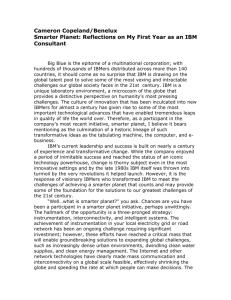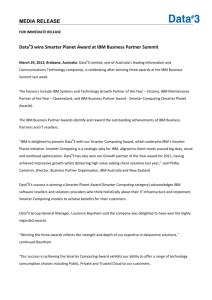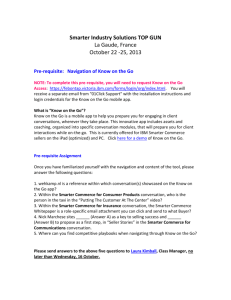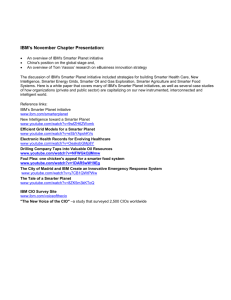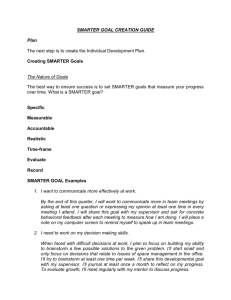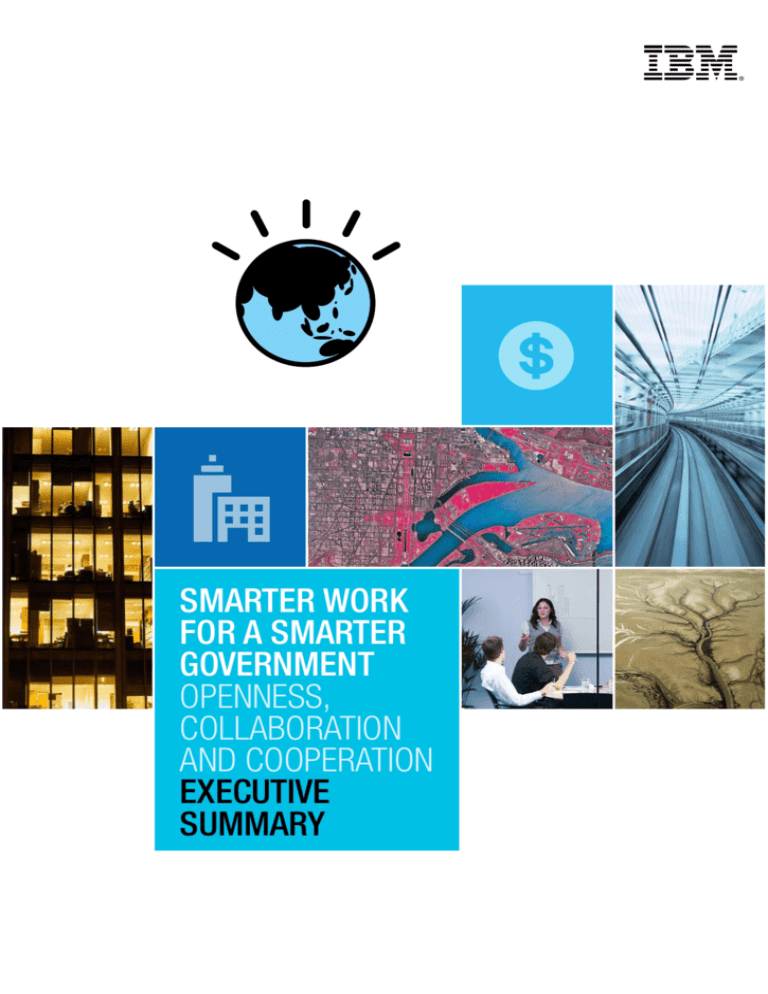
Smarter Work
for a Smarter
Government
Openness,
collaboration
and cooperation
Executive
Summary
Introduction
On 9 September 2009, IBM brought together a select group of senior government
leaders, generation Y future government leaders, and workforce industry professionals
to consider the challenges facing Australia’s public sector workforce – and the potential
to harness Web 2.0 technology to change the way Government collaborates, innovates
and serves its constituencies.
During the event, attendees considered and debated the characteristics of what a
smarter workforce, servicing a smarter government, might look like in the future, and
how we might get there. This executive summary provides an overview of the issues
discussed at the Forum, with a view to continuing this important conversation
throughout Australia’s public sector.
“ We need to connect citizens with each other, to
engage them more fully and directly in solving the
problems that face us. We must use all available
technologies and methods to open up the Federal
Government, creating a new level of transparency
to change the way business is conducted, giving
people the chance to participate in government
deliberations and decision making in ways that
were not possible a few years ago.”
Barack Obama
Government Leadership Forum • Executive Summary
1
Why do we need to
work smarter?
Australia’s aging population will lead to a reduced taxation pool and skills shortages. By
next year, for every ten people leaving the Australian workplace, there will only be eight
to replace them. By 2020, for every ten people leaving the Australian workplace, there
will only be six to replace them. Clearly, with fewer monetary and human capital
resources, the government of the future will need to ‘do more with less’.
Today, generational changes provide us with opportunities to leverage technology to
support this requirement. The digitally aware employees coming into the workforce are
natural proponents of more collaborative and efficient working practices based on social
networking tools and other Web 2.0 applications.
But the pressure for government to use Web 2.0 technology is not just internal. The
customers of government are already using social networking tools. The Department of
Veterans Affairs has clients in Yahoo Groups exchanging the details of DVA officers who
are considered particularly sympathetic and effective. Government has an opportunity to
bring such conversations into its own territory, so it can gain greater insights into both
citizen needs and its own operational efficiency.
What is ‘smarter
government’?
Smarter government is more than e-Government with a new name. It’s a fundamental
shift in the implementation of government toward an open, collaborative, cooperative
model. Technology and social tools will be an important part of this change but are,
essentially, an enabler in this process.
Smarter government makes a deliberate effort to break down barriers of bureaucracy
and introduce a more human face to government. It shifts the whole organisation of
government from being vertically and hierarchically driven to being much more open
and lateral in the way that information and people are managed.
For example, rather than outbound communication from agencies to the public, the
discourse becomes conversation among the public sector, between the public sector
and the community, and among the various parts of the community itself.
Government Leadership Forum • Executive Summary
2
What are the benefits?
Hugely improved collaboration
Smarter government provides a fractional cost model to make the collaborative process
extremely easy, driving productivity and fuelling innovation. A Harvard Business School
study showed that organisations with a culture of collaboration had productivity up to
250% greater than competitors with a culture of competition. Once collaboration is
made easy, people don’t need incentives to contribute their expertise. Anecdotal
evidence suggests they assist colleagues because they can and because they like to
demonstrate their expertise.
Access to expertise
Ease of collaboration naturally opens up new access to expertise – both from within
government and outside it. Internally, it makes it easy to identify the most suitable
experts to contribute to a particular project. Externally, opening up policy formation to a
community that wants to contribute offers significantly opportunities for enrichment. The
tools of social networking can provide a framework for an ongoing, sustainable and
open conversation between all arms of government, the academic world, the private
sector and individuals and communities with an interest in the business of government.
This sort of open conversation encourages cross-fertilisation of ideas and innovation.
Aggregated knowledge/shared content
Providing an infrastructure for people to connect and to share and build on each other’s
expertise aggregates organisational knowledge. For example, there is the potential to
develop departmental ‘Wikipedias’.
More agile policy development and
program delivery
Opening up the conversation to the public also creates the opportunity to deliver better
evidence-based policy and more targeted programs. It allows for ideas to be tested in
public and subject to change, as shifting priorities and needs are identified. For
example, in the UK, National Health System policy is being built in an ongoing process
based on direct feedback from patients in the system.
Government Leadership Forum • Executive Summary
3
De-mystification of the public sector
This sort of conversational approach keeps the public sector attuned to the needs
and wants of the public. At the same time, it de-mystifies the business of government
and creates trust. The more open conversation occurs, the less the public will be
baffled by bureaucracy.
Barriers to change
While lack of technological understanding can deter the adoption of Web 2.0
technologies, this is less of an issue than cultural resistance and risk issues.
Cultural resistance
Collaboration and innovation are not technical processes – they are cultural processes.
Collaboration and open conversation shifts the balance of power downwards,
empowering people in junior positions and the general public to add their knowledge
and thinking to important issues.
Just as the Catholic Church struggled with losing the mystery of leadership when the
Mass was no longer said in Latin, collaborative tools threaten government’s view of
itself. They have the potential to create massive and disruptive cultural change.
The biggest resistance is likely to come from middle management, which defines the
values and culture in most organisations.
Typically, executives embrace social software tools. For example, Westpac CEO, Gail Kelly,
has an internal blog where she connects with every member of her staff through a weekly
blog to keep people tied into the organisation’s vision and mission. Similarly, employees are
usually enthusiastic, because they know how to use the tools and can see their potential.
However, if the middle management team doesn’t model and encourage the use of
collaborative tools, the needed cultural change will not happen.
Government Leadership Forum • Executive Summary
4
Risks in how information might be used
Borrowing heavily from the culture of open source, smarter government assumes
that publicly open multiple and rapid iterations of policy, programs and ideas are a
good thing. However, open conversation and widespread publication is clearly not
appropriate for all types of government information.
The public sector is naturally cautious about the potential media backlash from
publicising data that is eventually proven to be incorrect. It is also concerned about
the risks involved in releasing some data, not to mention the considerable effort and
cost required to release robust information at all times.
If Australia’s governments are to achieve more openness, there will need to be
clear guidelines about what is appropriate for public discussion, as well as public
and media education about the expected quality of data put forward during
preliminary discussions.
Government Leadership Forum • Executive Summary
5
How do we create a
smarter government?
Consider technology last
According to Forrester Research, technology is the last consideration when planning for
collaborative tools. Forrester suggests the following process:
• People – who are we trying to reach?
• Objectives – what are we trying to achieve?
• Strategy – how are we going to do that?
• Technology – what technologies support that process?
Create the rules of engagement
Before implementation, it’s vital to establish the rules of engagement for each tool, from
a departmental blog to an internal social network. For example, the rules might specify:
“Please only comment on policy or programs about which you have
expertise, unless you’re asking for an opinion.”
“Please maintain similar standards of conduct as you would in a
departmental meeting.”
It is also important to have an appropriate response for people who step out of line and
a means for other users to report what they believe are abuses of the medium.
Integrate the technology
To encourage users to adopt Web 2.0 technologies, it’s important they are integrated
with existing tools. For example, users could be given the option to reply in an email or,
if the issue is of general interest in the department, as a blog.
Government Leadership Forum • Executive Summary
6
Quick wins in the first 100 days
Cultural change programs often fail because people are told change is coming, but fail
to see it happen. In the most successful change programs, leaders identify and
proactively implement specific actions in the first 100 days that demonstrate the
organisation is changing the way it works.
Individual leadership
Individual leadership is vital to achieve successful cultural change. One person cannot
affect a whole organisational culture, but they can change the 15 people whose
employment experience they are directly responsible for with the practice they take to
work every day.
Allow experiments
One of the key cultural changes required to promote innovation is for managers to
permit calculated risks and allow people to experiment. This means providing people
with the safety net that failure is an allowable possibility. For example, a senior
manager may agree to a four week trial with a limited budget. If the project is proven,
it may be extended with more time and more money. If not, the team learns from the
experience. This is a marked change from traditional organisational cultures, where
failure is seen as the worst possible outcome – as opposed to a natural consequence
of constant innovation.
Government Leadership Forum • Executive Summary
7
Conclusion
In the face of dwindling future resources, Australia’s governments
have an important opportunity to improve collaboration, productivity,
agility and efficiency by harnessing social media tools. This will
require substantial cultural change and the support of people at all
levels of government, especially Gen Y employees, who will be a key
group to lead and drive grassroots change.
References
Harvard Business Review, March 2009.
Groundswell: winning in a world transformed by social technologies.
Charlene Li and Josh Bernoff ©2009 Forrester Research Inc.
Further reading
Here comes everybody. Clay Shirky
Contributors
The contributors to this discussion were a select group of senior
government leaders, generation Y future government leaders, as
well as guest speakers including:
Stephen Collins, Founder, acidlabs
Ralph Demuth, Vice President, Software Group,
Technical Professionals and Services, IBM Asia Pacific
Matt English, Public Sector Strategic Initiatives Leader,
IBM Australia & New Zealand
Tim Gunnell, General Manager, Canberra, IBM Australia
Avril Henry, Author and Business Coach
Government Leadership Forum • Executive Summary
8
IBM, the IBM logo, ibm.com, Smarter Planet and the planet icon are trademarks of International Business Machines Corporation,
registered in many jurisdictions worldwide. Other product and service names might be trademarks of IBM or other companies. A current
list of IBM trademarks is available on the Web at www.ibm.com/legal/copytrade.shtml”. © Copyright IBM Australia Limited 2009.
ABN 79 000 024 733. © Copyright IBM Corporation 2009. All rights reserved. GL_10808
The views represented in this document are those expressed by various participants and concluded during the Australia’s Leadership
Forum. They are not specifically or solely the views of IBM. The recommendations detailed in this document are those drafted by IBM
based on discussions during the Australia’s Leadership Forum and supported by the Forum. IBM does not warrant the accuracy and
correctness of any of the information contained in this paper.


